Young minds excelled at national level Hackathon
Amidst the quarantine, students of SRM AP and members of NEXT TECH LAB, have exhibited their expertise in HACKNITR, a national level hackathon organized by NIT Rourkela on 21-22 March 2020. The outstanding merit of their project has enabled them to bag the Runner-Up and 2nd Runner-Up position at the hackathon.
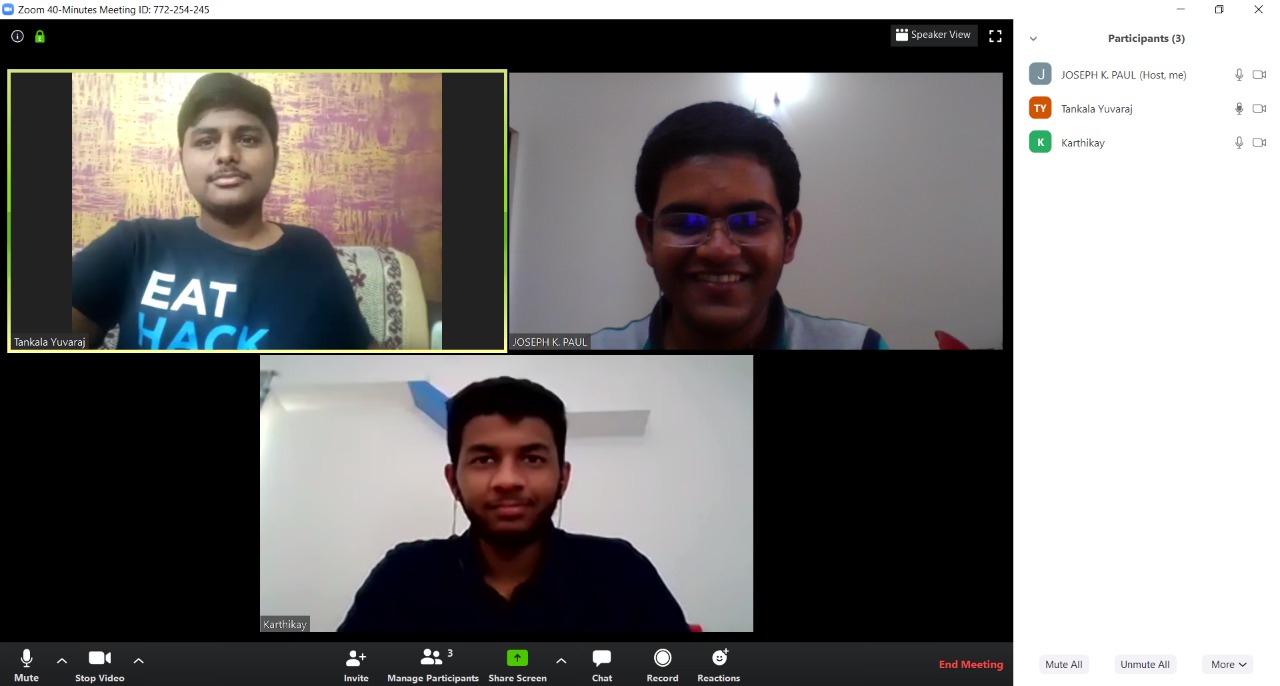 Team ASTUTE BOTS consulting
Team ASTUTE BOTS consulting
Team ASTUTE BOTS, comprising of 1st-year students, Tankala Yuvaraj, Karthikay Gundepudi and Joseph K. Paul, was recognized as the Runner-Up. They used the AI-IoT platform to develop DRONEYES; a prototyped solution that can be used to reduce poaching. It is an aerial reconnoiter which flies in stealth mode and takes the video or photo of a suspected poacher. This is done by the highly trained object detection model called YOLOv3. These eyes not only detect objects on the terra firma but also sends the exact location via GPS. “With the help of cloud technology, we can share the data in real-time so that the user/organization can take the required initiative by locating the exact place of poaching”, explains Karthikay. We were inspired to attend hackathons by Anshuman Pandey, and Next Tech Lab supported this achievement.
Another team PUSH, where Karthik Epperla, 2nd year, and Ishita Agarwal, 1st year, participated, has received the 2nd Runner’s up award. The students worked on an AI-VR-Blockchain based application to help people with autism improve communication, social and other basic abilities required to live in a society. It gives a set of YES/NO questions that are to be answered by either the parent of the child or the adult suffering from Autism and then it matches those answers with the dataset which then returns the level of autism that the child/adult is suffering from. Depending on the level, the user can choose the extremity of VR therapy. When the child goes through the VR session, the parent can view what their child/ adult is doing in the virtual environment using the parent app from anywhere and advise their ward offering extra support to the patient. ” Our application has 3D simulations of real-life situations wherein autistic children/ adults (mostly children) can practice and understand how to behave/react in those situations and overcome their fear while facing a similar situation in real life. “, adds Karthik.
Karthik acknowledges Adithya Ramakrishnan the founder of Next Tech Lab and his lab mate, Lakshmi Vallala for implanting the noble idea that AI can help in the rare medical condition, Autism. They have constantly been in touch with a few special schools and treatment centers to know about the behaviour and nature of autistic people so that they can keep on building different versions of applications.
In the natal stage of their academic career, the students are guided and nurtured in an environment by the Next Tech Lab and the faculty members which inspires them to positively impact the society. The ample exposure offered to the students will not merely encourage them, but also enable them to improve their concepts.
Small-World Wireless Sensor Network to Help Making Smart Applications for Industries
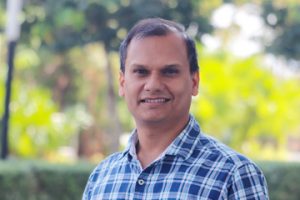 Dr Om Jee Pandey, Assistant Professor, Department of Electronics and Communication Engineering, has recently published two papers in renowned IEEE journals. His paper “Secrecy Performance Analysis of Two-way Relay Non-Orthogonal Multiple Access Systems” was published in IEEE Access Journal, having an impact factor: 4.06. Whereas, “Fault-Resilient Distributed Detection and Estimation over an SW-WSN Using LCMV Beamforming” was published in IEEE Transactions in Network and Service Management (Impact factor: 4.682). The study was done in associations with Prof. Rajesh M Hegde, Department of Electrical Engineering, IIT Kanpur and Prof. Ha H. Nguyen, Department of Electrical and Computer Engineering, University of Saskatchewan, Saskatoon, Canada. His research was focused on developing efficient Wireless Sensor Network services in small-world models. The proposed research can be applied in developing many state-of-the-art applications in the areas related to healthcare systems, climate-smart agriculture, intelligent transportation, home automation, manufacturing, smart utilities, and industries etc.
Dr Om Jee Pandey, Assistant Professor, Department of Electronics and Communication Engineering, has recently published two papers in renowned IEEE journals. His paper “Secrecy Performance Analysis of Two-way Relay Non-Orthogonal Multiple Access Systems” was published in IEEE Access Journal, having an impact factor: 4.06. Whereas, “Fault-Resilient Distributed Detection and Estimation over an SW-WSN Using LCMV Beamforming” was published in IEEE Transactions in Network and Service Management (Impact factor: 4.682). The study was done in associations with Prof. Rajesh M Hegde, Department of Electrical Engineering, IIT Kanpur and Prof. Ha H. Nguyen, Department of Electrical and Computer Engineering, University of Saskatchewan, Saskatoon, Canada. His research was focused on developing efficient Wireless Sensor Network services in small-world models. The proposed research can be applied in developing many state-of-the-art applications in the areas related to healthcare systems, climate-smart agriculture, intelligent transportation, home automation, manufacturing, smart utilities, and industries etc.
In order to develop efficient Wireless Sensor Network (WSN) services, several methods have been proposed for node localization, clustering of sensor nodes, new routing algorithms, adaptive duty cycles, usage of mixed-transmission models, placement of intelligent gateways, usage of mobile elements, and bypassing holes. However, the introduction of small-world characteristics in a WSN has hitherto not been used in this context. A small-world network is typically characterized by a low average path length and high average clustering coefficient and has been widely used to model social networks. However, small world models have not been used in the development of WSN. The primary objective of this research is to develop small world models for WSN services such as sensor node localization, data gathering, data fusion, network lifetime maximization, energy-balancing, reduced data transmission delay, time synchronization, energy-harvesting, and robust distributed detection and estimation. A small world WSN reduces the number of hops required for data transmission, and maximal utilization of sensor nodes closer to the sink. Other advantages of small world WSN include efficient bandwidth utilization, increased network lifetime, and fast convergence of event detection and parameter estimation. Small world WSN developed in tandem with novel routing strategies leads to improved WSN services for various applications.
In WSNs, sensor devices transfer the data cooperatively using multiple hops over a network. Multiple hops required for data transmission over a WSN leads to reduced network performance in the context of device localization, energy efficiency, energy balancing, data latency, speed of event detection and parameter estimation, and network robustness. This is because of poor distance estimation between sensor device pairs, maximum utilization of sensor devices closer to the sink, and a short radio range of sensor devices. Hence, the primary focus of this research work is to reduce the number of hops required for data transmission. In this context, Small World Characteristics (SWC) can be introduced in a WSN, leading to a small world WSN (SW-WSN). An SW-WSN is a well-connected network with reduced hop counts between node pairs.
Small world phenomena were first observed by Stanely Milgram in social connectivity of people. Later, it came out as a theory of “six degrees of separation”. Six degrees of separation claims that all people are six, or fewer, social connections away from each other. This theory is also known as the 6 Handshakes rule. Further, small-world phenomena have been investigated in graphs. Subsequently, SWC is observed in wireless networks. In general, small world WSNs (SW-WSNs) are characterized by low Average Path Length (APL) and high Average Clustering Coefficient (ACC). For an undirected WSN with N nodes, representing a regular network, the APL increases linearly with the number of nodes present in the network. On the other hand, in a WSN having SWC the APL, between two randomly selected nodes grows proportionally to the logarithm of the number of nodes in the network. “WSNs are spatial graphs, where links are created using radio connectivity. There is a limit on the radio range of a sensor node, hence in such networks, the long-range connections are generally absent. Thus, these networks are clustered, but they do not experience small-world phenomena. Hence, the primary focus of this work is to develop SW-WSN using various methods leading to efficient WSN services” explained Dr Pandey.
Dr Pandey is now busy to take the studies further. His future projects include-
• Small World WSN (or SW-WSN) Development for Smart Healthcare.
• Cognitive SW-WSN for Energy-Efficient CPS and IoT applications.
• Climate Smart Agriculture using Cognitive SW Characteristics.
• Low-Latency and Intelligent Transportation over small world CPS.
• Multi Sensor Fusion over SW-WSN for CPS/IoT Applications.
• Information and Context Quality in WSN, IoT and CPS Networks.
- Published in ECE NEWS, News, Research News
Next-Tech Lab Scaling New Heights: Won Three Hackathons in a Row
The unstoppable team of Next-Tech Lab of SRM University- AP, has again brought laurels to the University by winning three hackathons in a row. During this lockdown while some devoted their time to newfound hobbies, our young researchers successfully developed a fresh multiplayer virtual reality game – ‘Whack A Mole’ and a cloud-based multiplayer FPS in Virtual Reality- ‘Desert Shooter’. The three-member team has successfully bagged the second prize in the International / Professional Award at SKYHacks2020; Best echoAR Hack at Silicon Valley Hacks; and Best AR/VR hack at HackNow, organized by Cal Hacks, a non-profit organization at the University of Berkeley, California.
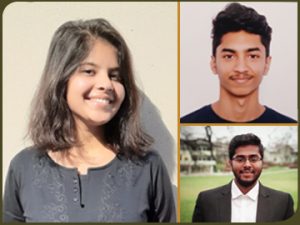
Karthik, Koushik & Khushboo (Clockwise)
When asked how the idea of making such a game crossed their minds, Epperla Karthik, a 2nd Year student of Computer science and Engineering and a member of the team, said, “My family loves attending Tradeshows, every time we attend one my dad and I challenge each other to win a game of Whack A Mole. But, due to strict quarantine that my family is following, it’s been a while now for such challenges. My teammates and I, being gaming and virtual reality enthusiasts, decided to develop a VR version of ‘Whack A Mole.’”
‘Whack A Mole’ is a multiplayer virtual reality game that allows users to play against the computer or their families or both! One can use it on iOS or Android. It is built on Unity3D, on top of Photon PUN and GoogleVR SDK. It is also integrated with Google Firebase. “This was the very first time we were working on the development of virtual reality games and networking. As we had to run the game on our phone to record the gameplay, the output video on YouTube is a bit blurry,” explained Khushboo Sharma, another member of the team and a 2nd-year student of Computer Science and Engineering. “We completed the development of the game in only 20hrs, starting from scratch. We developed a few of our own UI elements and game assets. I feel the User-Interface of the app and the effects are pretty cool. VR development is real FUN! Moreover, there are a lot of API and SDK that unity supports,” exclaimed Koushik Bhargav, a 3rd-Year student of Computer Science and Engineering and the third member of the team.
‘Desert Shooter’ is another multiplayer virtual reality game developed by the team that allows users to play against the computer or their families or both. You can connect with your friends and play together. The game consists of a swarm of robot ships moving towards you and you have to protect yourself from them. “The interesting part is that all of this happens in Mixed Reality which makes the game immersive. We built it on Unity3D, on top of Photon PUN and GoogleVR SDK, Echoar. It is also integrated with Google Firebase and the assets are stored in echoar cloud. This project won the best AR/VR hack at “Hack: Now” which is organized by the University of California Berkeley,” said Epperla Karthik.
The team has plans to make this game to be a cross-platform game. Therefore, their next plan of action is to make the web version of it. The team is also planning to release it to production so that users can have an immersive experience of modern gaming techniques.
It is again proved that pure talent can never be put in quarantine. It will always find a way to express itself to the world. Our young developers have brilliantly used the ample time and opportunity to put their brains in best use and to bring recognitions from nationally and globally acclaimed competitions.
- Published in CSE NEWS, News, Students Achievements
Cost-effective shield against Coronavirus
Dr. Panchagunula Jayaprakash designs an improved alternative to regular masks
Dr. Panchagunula Jayaprakash, Assistant Professor, Department of Mechanical Engineering, has designed a FACE SHIELD embedded with 3D printing technology. During this pandemic that has led to an unprecedented global crisis, this face protection devised to protect users from the Novel Coronavirus, is made available at the minimum rate of Rs. 20 each. The major drawback of the commercially available Face Shields for engineering applications is its heavy weight which causes discomfort if worn for a longer period of time. This face mask that uses 3D printing technology alleviates the limitations of the regular masks currently used by doctors, policemen, and journalists.
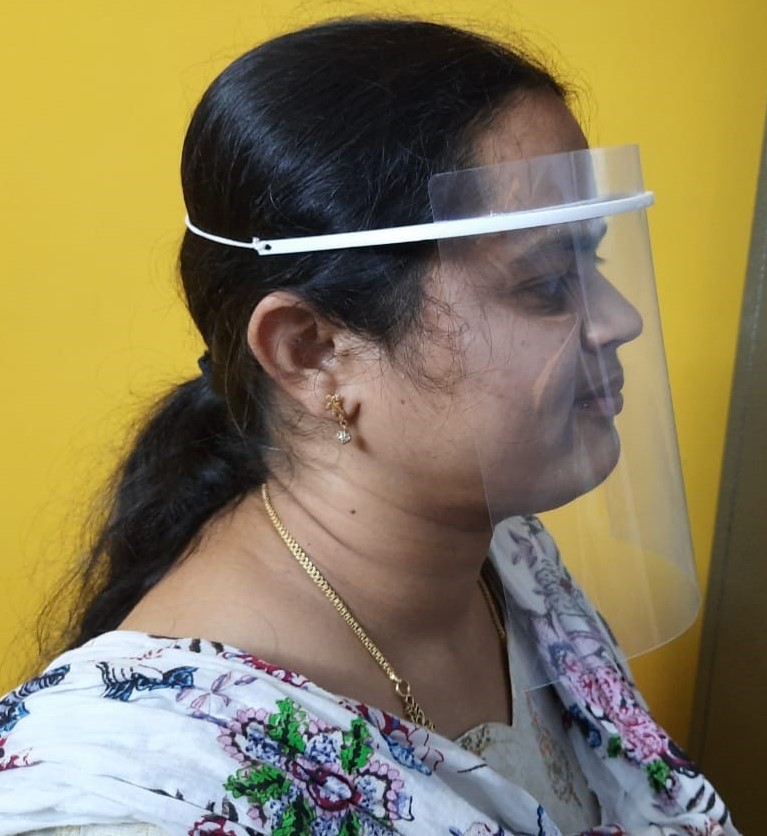 Head mounted Face Sheild
Head mounted Face Sheild
“With the advent of Covid-19, and due to the shortage of personal protective equipment, the health workers such as Doctors, Sanitary staff and Police are also getting infected. As they are the backbone of the society, I thought of designing a light weight Face Shield using 3D Printing (3DP) or Additive Manufacturing technique. The rudimentary advantages of 3D printing technology is the design flexibility and less lead time to manufacturing. “, explains Dr. Jayaprakash.
 Creation of CAD model
Creation of CAD model
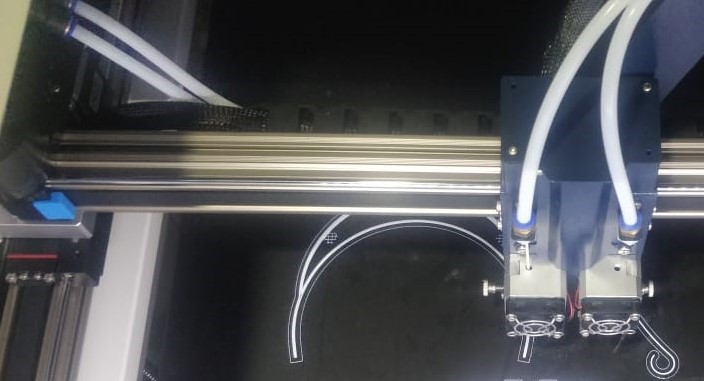 3D Printing
3D Printing
The regular masks barely cover the nose and mouth, whereas the Face Shield will be able to protect the eyes, mouth, nose, and ears so that one cannot get infected by the virus. Some of the medical and police personnel who use the regular masks suffer from facial irritation, making the Face Shield a comfortable and more effective alternative for all government officials on Covid-19 duty.
 Physical component
Physical component
Dr. Jayapraksh further says, “While manufacturing the Face Shield, 3D printing technology is used for designing a headband, upon which a 100 micron thick transparent plastic sheet is attached to ensure superior protection against the virus. It prevents air, dust, and liquids that are contaminated to come in contact with people. Also, there are no probable side effects on using the mask. If the government approves of its marketing, the face mask can be distributed among the public to prevent the widespread of Novel Coronavirus.”
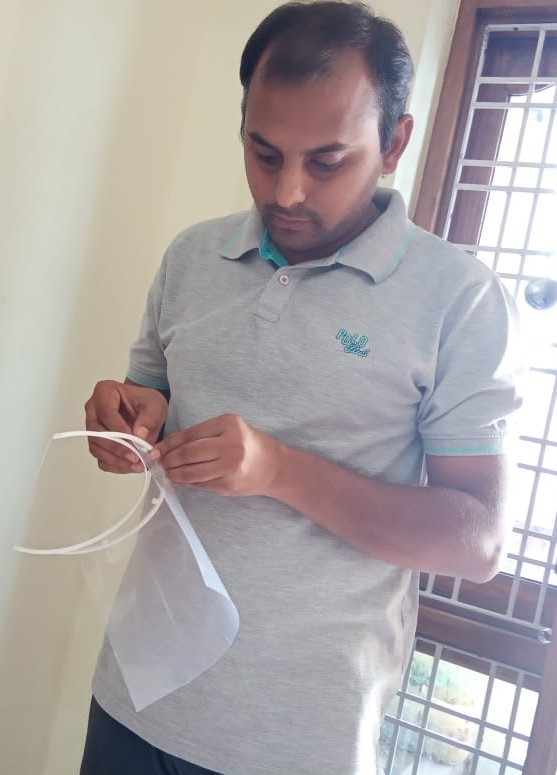 OHP sheet assembly
OHP sheet assembly
The management of SRM AP, Andhra Pradesh applauds Dr. Jayaprakash on designing the mask after relentlessly working on it for several days. Prof. Narayana Rao, Pro Vice-Chancellor of the University, has written to Adimulapu Suresh, Minister of Education, Andhra Pradesh, and Alla Kalikrishna Srinivas, Deputy Chief Minister of Andhra Pradesh, Minister for Health, Family Welfare and Medical Education, Andhra Pradesh, highlighting the importance of the facial cover and the many ways it can be regarded as a boon to the society as a whole. He said that the Face Shield would be beneficial to millions of students who would be attending regular classes once the educational institutions reopen.
- Published in Mechanical Engineering NEWS, News, Research News
Online adaptive fast output voltage tracking in DC power supply system
Remarkable research of Dr. Tousif Khan N is honoured with APJ Abdul Kalam Memorial International Travel Award
 SRM University AP, Andhra Pradesh faculty, Dr. Tousif Khan N, Assistant Professor and Head of the Department, Department of Electrical and Electronics Engineering, is to present a paper “Laguerre Neural Network Driven Adaptive Control of DC-DC Step Down Converter” in the renowned International Federation for Automatic Control (IFAC) World Congress to be held in Germany during July 12-17, 2020. Further this research article is also selected for the prestigious APJ Abdul Kalam Memorial International Travel Award by the Automatic Control and Dynamic Optimization Society (ACDOS) chaired by Professor Ravi Gudi of Indian Institute of Technology Bombay.
SRM University AP, Andhra Pradesh faculty, Dr. Tousif Khan N, Assistant Professor and Head of the Department, Department of Electrical and Electronics Engineering, is to present a paper “Laguerre Neural Network Driven Adaptive Control of DC-DC Step Down Converter” in the renowned International Federation for Automatic Control (IFAC) World Congress to be held in Germany during July 12-17, 2020. Further this research article is also selected for the prestigious APJ Abdul Kalam Memorial International Travel Award by the Automatic Control and Dynamic Optimization Society (ACDOS) chaired by Professor Ravi Gudi of Indian Institute of Technology Bombay.
The research work of Dr. Tousif proposes a novel Laguerre neural network estimation technique for the approximation of unknown and uncertain load function, followed by its subsequent compensation in the adaptive backstepping controller. A detailed design of the proposed estimator and adaptive backstepping controller along with closed loop asymptotic stability have been presented. Further, the proposed control mechanism is evaluated through extensive numerical simulations while subjecting the converter to input voltage, reference voltage, and load resistance perturbations. Furthermore, the results are verified by testing the proposed controller on a laboratory prototype with DSP based TM320F240 controller board. The analysis of results reveals that the proposed control methodology for DC-DC step down converter offers a faster transient output voltage tracking with smooth and satisfactory inductor current response over a wide operating range. Dr. Tousif informs, “Under the class of DC-DC converters, the dynamics of DC-DC step down converter are nonlinear in nature and are largely influenced by both parametric and unanticipated external perturbations. In its closed loop operation, obtaining a precise output voltage tracking besides satisfactorily inductor current response is a challenging control objective. Hence, in this regard, this article proposes a solution.”
Electric power supply is the principal entity behind any electrical circuits and systems. Irrespective of their function in the digital domain, these circuits necessarily require a reliable and efficient energy source for their operations. Among the two existing forms of electrical energy, namely, the direct current (DC) and the alternating current (AC), the DC power finds wide use in numerous applications in the field of telecommunication, instrumentation, medical electronics, aerospace, defence and power transmission.
Ever since the fundamental innovations in DC systems by Thomas Alva Edison in 1880, DC rectification, and modulation method have remained central to various utilities. During the initial years, DC power conversion primarily resorted to the use of vacuum tube technology in delivering a desirable level of voltage from an AC source. The rectification stage was subsequently followed by filtering of the voltage at the output end. Nonetheless, the vacuum tube technology supported very low current density and featured a high ripple content in the DC voltage. Additionally, the output voltage was inconsistent or rather unregulated, making it inappropriate for DC power operated electrical and electronic systems. Much later in 1967, integrated series regulators were developed which eventually became popular as linear power supplies (LPS). Such a classical DC power generation method involved an AC transformer, AC-DC rectifier, and a voltage regulator in its assembly. The transistors in LPS operate under active region and dissipate large amounts of heat due to the voltage drop while high current flows through the collector-emitter junction, thereby causing substantial power loss and a very low energy efficiency. Even though they characterize the low level of noise and find better suitability in audio applications, yet their critical limitations of huge size, heavy weight and high cost make them infeasible for use in portable electronic devices.
In tandem to these aforementioned developments, the advancements in power semiconductor technology led to the invention of low cost reliable power switches exhibiting fast switching response. This proved to be instrumental in building an energy efficient switched mode power supply which gradually gained popularity. “Its impact on electrical technology was phenomenal, replacing conventional linear voltage supplies with switched mode power supplies giving rise to enhanced efficiency, light weight, compactness, and comparably lower cost. Such a modern DC conversion system primarily includes DC-DC converters, wherein the rectified input voltage is fed to the DC-DC converter circuits for obtaining specific voltage levels. The primary objective in DC-DC converters is to transfer the energy among different DC circuits functioning at a specific voltage and current levels. This process of energy transfer is performed by temporarily storing the energy from the input source in an operating mode, followed by releasing it in the other operational mode of the converter. Thus, one level of DC input voltage is converted to another level of average DC output voltage at the load end. Meanwhile, the converter being ideal is expected to consume no energy. Any consumption of energy in the converter interface amounts to direct power loss in the overall supply system. Typically, converters render high input-output conversion.”, enlightens Dr. Tousif Khan N. His notable research work offers to mitigate these issues, leading to the venerated APJ Abdul Kalam Memorial International Travel Award. Advancing his work in the future, Dr. Tousif will be closely working on the society’s activities with ACDOS as a member for mutual benefit.
- Published in Departmental News, EEE NEWS, News, Research News
SRM AP’s collaboration with IIRS-ISRO enable students to avail outreach programmes
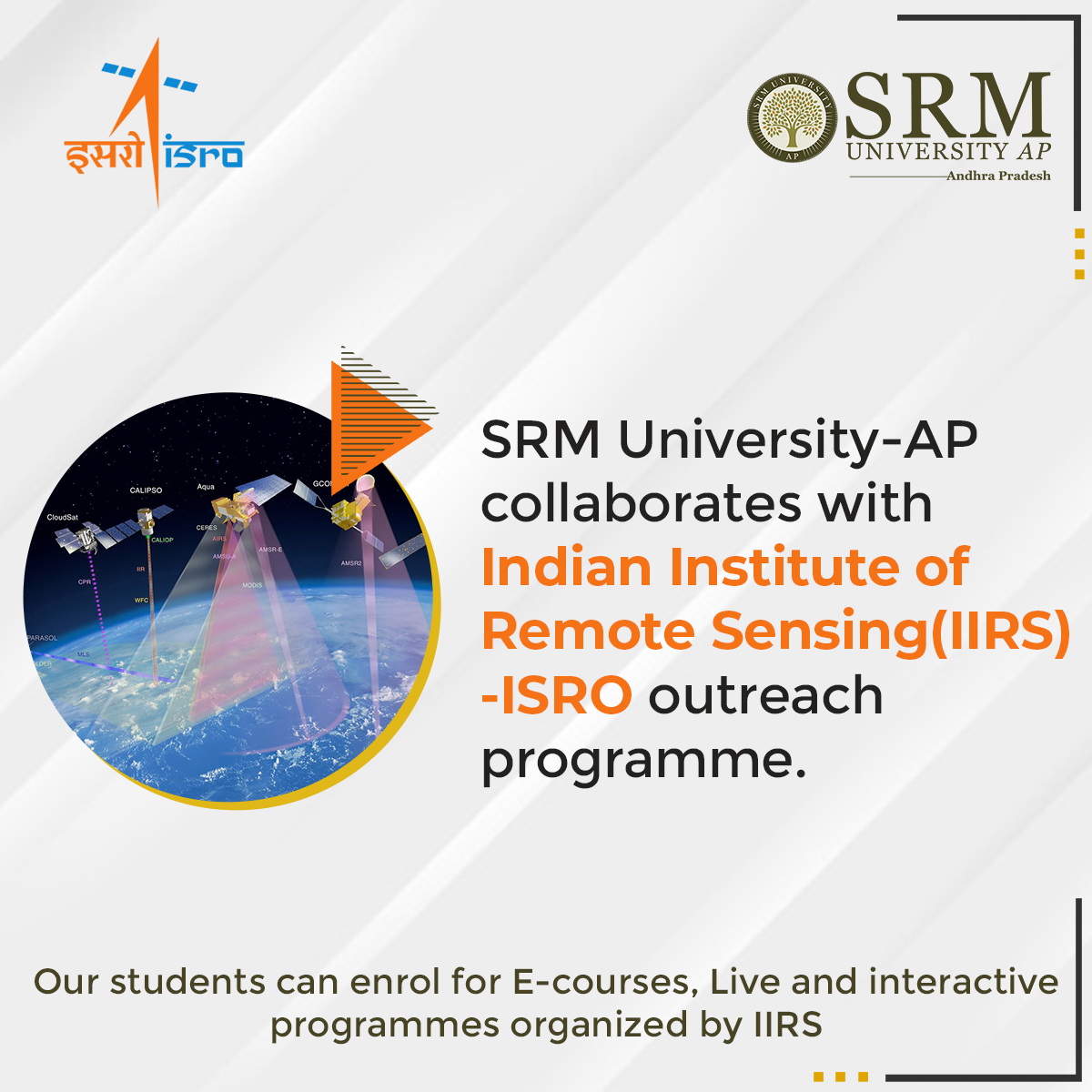 SRM University AP-Andhra Pradesh has collaborated with the Indian Institute of Remote Sensing (IIRS) -Indian Space Research Organization (ISRO)’s outreach programme. SRM AP is included among the top-notch universities of India that can benefit from the incomparable Outreach Programme. As part of the association, the students of SRM AP will have the excellent opportunity to register for annual courses as well as live and interactive programmes being organized by IIRS. In addition, E-learning courses for a short span of 3-4 Month duration will be accessible by the students.
SRM University AP-Andhra Pradesh has collaborated with the Indian Institute of Remote Sensing (IIRS) -Indian Space Research Organization (ISRO)’s outreach programme. SRM AP is included among the top-notch universities of India that can benefit from the incomparable Outreach Programme. As part of the association, the students of SRM AP will have the excellent opportunity to register for annual courses as well as live and interactive programmes being organized by IIRS. In addition, E-learning courses for a short span of 3-4 Month duration will be accessible by the students.
 Please view the annual course calendar 2020 here
Please view the annual course calendar 2020 here
ISRO is among the best-performing government organizations in India which has mastered the sophisticated space technologies, along with receiving applauds globally. The organization’s brilliant research and development, and applications for societal benefits like tele-education, telemedicine, disaster management, agriculture, fisheries and infrastructure development, ensures its dominance in the world. ISRO has launched the IIRS Outreach Programme to strengthen academia in terms of Space Technology & its applications through online learning platforms.
The popularity of remote sensing, geographical information system, global navigation satellite system and associated geospatial technologies in the current times require trained manpower in the domain. The students of SRM AP are encouraged to proactively avail the interactive distance learning courses and webinars that will enable the students to achieve their career goals in aerospace and geospatial technologies and make a mark globally.
Know more about Registration: https://elearning.iirs.gov.in/outreach.php
Register here: https://elearning.iirs.gov.in/Registration.php
 Click here to know more about the registration procedure
Click here to know more about the registration procedure
For additional information or clarification, please contact programme coordinator:
Prof. Siva Sankar Yellampalli
Professor of Practice & Head of the Department,
Department of Electronics and Communication Engineering
E-mail: sivasankar.y@srmap.edu.in
Contact No: 7760280268
Energy-Efficiency Optimization over Full-Duplex IoT Networks Towards Commercial Applications
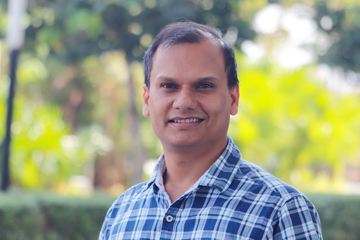 Dr Om Jee Pandey Two research papers of Dr Om Jee Pandey, Assistant Professor, Department of Electronics and Communication Engineering, have been accepted in reputed IEEE Journals. The papers titled “Multiuser Full-Duplex IoT Networks with Wireless-Powered Relaying: Performance Analysis and Energy Efficiency Optimization,” and “Time Synchronized Node Localization Using Optimal H-Node Allocation in a Small World WSN” are going to be published in IEEE Transactions on Green Communications and Networking and IEEE Communications Letters, respectively. The paper “Multiuser Full-Duplex IoT Networks with Wireless-Powered Relaying: Performance Analysis and Energy Efficiency Optimization,” was pursued in collaborations with Prof. Ha H. Nguyen, Department of Electrical and Computer Engineering, University of Saskatchewan, Saskatoon, Canada, and Dr Mahendra K. Shukla, who is associated with Macau University of Science and Technology as a Post Doctoral Fellow.
Dr Om Jee Pandey Two research papers of Dr Om Jee Pandey, Assistant Professor, Department of Electronics and Communication Engineering, have been accepted in reputed IEEE Journals. The papers titled “Multiuser Full-Duplex IoT Networks with Wireless-Powered Relaying: Performance Analysis and Energy Efficiency Optimization,” and “Time Synchronized Node Localization Using Optimal H-Node Allocation in a Small World WSN” are going to be published in IEEE Transactions on Green Communications and Networking and IEEE Communications Letters, respectively. The paper “Multiuser Full-Duplex IoT Networks with Wireless-Powered Relaying: Performance Analysis and Energy Efficiency Optimization,” was pursued in collaborations with Prof. Ha H. Nguyen, Department of Electrical and Computer Engineering, University of Saskatchewan, Saskatoon, Canada, and Dr Mahendra K. Shukla, who is associated with Macau University of Science and Technology as a Post Doctoral Fellow.
 Block diagram of the full-duplex
Block diagram of the full-duplex
wireless-powered relay based on power splitting There has been a growing interest in improving energy efficiency for next-generation Internet of Things (IoT) networks due to the increasing demand for green communications. Motivated by this demand, energy efficiency maximization has been investigated for several networks. Specifically, without considering simultaneous wireless information and power transfer networks, various works have extensively studied energy efficiency maximization for half-duplex networks and full-duplex networks. Further, by considering simultaneous wireless information and power transfer networks, several works have examined energy efficiency maximization in half-duplex networks. Moreover, energy efficiency for next-generation IoT networks with simultaneous wireless information and power transfer has also been studied by considering half-duplex transceivers. It appears that energy efficiency problems for multiuser full-duplex IoT networks have not been studied in the open literature.
 Multiuser FD-IoT network with
Multiuser FD-IoT network with
wireless-powered TWR Motivated by the above discussion, in this work we consider a full-duplex IoT network in which a multi-antenna access point and several single antenna IoT devices exchange information bidirectionally with the aid of a wireless-powered single-antenna relay, under generalized Nakagami-m fading channels. In particular, we consider the power splitting protocol at the full-duplex relay terminal, and each communication terminal operates in the full-duplex mode. For such a network, we first formulate the instantaneous end-to-end signal-to-interference-plus-noise ratios (SINRs) by employing maximum-ratio transmission (MRT) beamforming and maximum-ratio combining (MRC) at the access point A, as well as IoD scheduling. Then, based on the obtained SINRs, we evaluate the overall outage probability and ergodic sum-rate of the network. Furthermore, we develop an optimal power allocation to maximize the network’s EE.
 Integral area for the
Integral area for the
overall outage probability Recently, with many technological advancements in wireless data transmission, IoT is expected to affect all aspects of our daily lives with its ever-growing and emerging applications. Traditional wireless communication networks are usually limited by the operational time of energy-constrained devices, and therefore energy consumption minimization is a crucial factor in IoT networks. Simultaneous wireless information and power transfer have emerged as a sustainable solution to the scenarios where replacing or recharging batteries is very costly, and may even be impossible. The basic idea of simultaneous wireless information and power transfer is that since radio frequency signals can carry information and energy at the same time, the received radio frequency signals can be utilized for energy harvesting to keep the energy-constrained devices operational. Existing studies adopt two different protocols, namely time switching and power switching, to implement simultaneous wireless information and power transfer receiver architecture. With these protocols, either the power or time of the received signal is split so that one part is used for information processing, and the other is used for energy harvesting.
The proposed research can play a crucial role in societal development as it can be applied in developing many state-of-the-art applications in the areas related to green healthcare systems, energy-efficient agriculture systems, green transportation, low power home automation, green manufacturing, low power smart utilities, and energy-efficient industries etc.
His other paper “Time Synchronized Node Localization Using Optimal H-Node Allocation in a Small World WSN”, DOI (identifier) 10.1109/LCOMM.2020.3008086, has been done in collaborations with Prof. Rajesh M Hegde, Department of Electrical Engineering, IIT Kanpur and Dr Mahendra K. Shukla, Post Doctoral Fellow at Macau University of Science and Technology. To know more about Dr Pandey’s work in the domain of Small-World Wireless Sensor Network, visit- https://srmap.edu.in/news/dr-om-jee-pandey-small-world-wireless-sensor-network-help-making-smart-applications-industries/.
Dr Pandey is now not only working for the commercial applications of his current research but also has devoted himself to his future projects, that include-
Full-Duplex Network Development for Green Healthcare Systems.
Energy-Efficient Cyber-Physical Systems and Internet of Things.
Development of Energy-Efficient Agriculture Systems.
Green and Intelligent Transportation over Full-Duplex Context-Aware Pervasive Systems.
- Published in ECE NEWS, Faculty, News, Research News
Artificial Intelligence: The Future of Healthcare in India
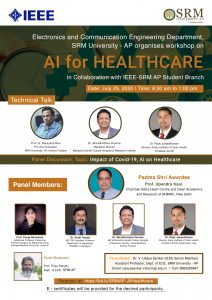 Department of Electronics and Communication Engineering, SRM University-AP, Andhra Pradesh organised an insightful workshop on “Artificial Intelligence (AI) for Healthcare” in collaboration with IEEE-SRM AP Student Branch on 25th July. Prof. D. Narayana Rao, Pro-Vice-Chancellor, inaugurated the session. The workshop was divided into two sessions.
Department of Electronics and Communication Engineering, SRM University-AP, Andhra Pradesh organised an insightful workshop on “Artificial Intelligence (AI) for Healthcare” in collaboration with IEEE-SRM AP Student Branch on 25th July. Prof. D. Narayana Rao, Pro-Vice-Chancellor, inaugurated the session. The workshop was divided into two sessions.
1. Technical presentation
2. Panel discussion
Dr Muralikrishna Voonna, Managing Director, Mahatma Gandhi Cancer Hospital & Research Institute, and Dr Rajiv Janardhanan, Director, Amity Institute of Public Health, Professor ACVB participated in the technical presentation. Dr Voona delivered a lecture on “Impact of AI in Clinical Healthcare” whereas Dr Rajiv Janardhanan spoke on “Sustainable Healthcare: AI-enabled platforms for Affordable and Accessible Healthcare Solutions”.
Eminent panellists such as Padma Shree Awardee Prof. Upendra Kaul, Dr Pooja Ramakant, Dr Sunil Taneja, Dr Muralikrishna Voonna, and Dr Rajiv Janardhanan interacted on “Impact of Covid-19, AI on Healthcare” during the second half of the session. Prof. Priya Ranjan, Department of ECE, SRM-AP, acted as the moderator of the session. Dr Udaya Shankar V, Assistant Professor, Department of ECE, was the coordinator of the workshop.
In his opening remarks, Prof. D. Narayana Rao asserted that healthcare in India faces significant challenges on quality, accessibility and affordability for a large section of the Indian population. Many healthcare experts are aware that in India, 70% of healthcare infrastructures are in the cities which caters only to 30% of India’s Population. “The shortage of doctors, lack of infrastructures, different mindset about the urban and rural population of the country and low government spending on the healthcare are very much motivating India towards innovative and sustainable and affordable technology to improve the quality of life,” said Prof Rao. He further mentioned that AI in Indian healthcare is expanding at a significant rate of 40% approximately. The AI-enabled health services such as automated analysis of medical tests, predictive healthcare diagnosis with the help of monitoring equipment and wearable sensor-based medical devices are expected to revolutionise medical treatment process in the country. AI is being extensively used in six healthcare segments such as hospital administration, pharmaceuticals, diagnostics, medical equipment and supplies, medical insurance and telemedicine. “Moreover, hospitals can implement patient-centric plans with the help of AI to avoid unnecessary hospital procedures and making healthcare services faster in India. The Government of India also shows its keen inclination as in the past week, the Hon’ble prime minister Sri Narendra Modi had a discussion with the CEO of IBM regarding the development of AI-enabled medical instruments for healthcare in the country. Needless to say, there are a plethora of opportunities for new engineers and doctors,” opined Prof Rao.
In his talk, Dr Murali Krishna Voonna confirmed that Artificial intelligence has a huge potential to become a transformational force in healthcare. It allows humans to gain unprecedented insights into diagnosis, care process, treatment variability and patient outcomes. Nowadays, machine learning uses statistical technics to give computing systems to learn with incoming data to identify patterns and make decisions which will help the doctors to assess risks, make a correct diagnosis, and offer more effective treatments. Robot-assisted surgery is now being widely popular for the precision and accuracy in performing a complicated surgery. AI is world’s one of the highest growth industries projected to reach $150 billion by 2026. It can compensate for physician biases and be used in personalised therapy by studying genome. Dr Voonna further informed that there is a huge scope for development in the segments such as brain-computer interface, next-generation radiology tools, creation of precise analytics for pathology images, expanding access to treat underserved regions, clinical decision support etc. to name a few. “Several reputed companies have invested in India to improve the AI in healthcare. NITI Aayog is working with Google to develop artificial intelligence ecosystems in India both in training and research. They have started a National Research Strategy for Artificial Intelligence recently. National Digital Health Authority has been formed as a regulatory body which is going to make the regulation in the Artificial Intelligence in start-ups and business and commercialisation of the products. Still, AI in healthcare is a decision support tool but not a decision-making tool,” explained Dr Voonna.
In the opinion of Dr Rajiv Janardhanan, the healthcare disparity continued because the investments of the government in the years after independence is less than 2 %. COVID-19 has turned out to be a blessing for health care as it made people especially policy-makers to realise that the healthcare infrastructure needs to be improved drastically. The AI-enabled intelligent support system is required because of budget constraints, rising costs of advanced medical treatments, increased complexity and cost of delivering healthcare, as well as increased expectations and demand for quality patient-centred healthcare. India comprises of a healthcare ecosystem where 80% of the healthcare is expensive, and 70% of the population is living in rural areas with marginalised and inaccessible healthcare. This makes the rationale to develop tools which are community empowering. “Knowledge dissemination of health literacy is required necessarily to increase the productive hours of the nation. When we empower the stakeholders with health literacy it directly aligns with the health promotion efforts, provides a rationale with community-empowering policy decision making, where the weakest stakeholder in the healthcare system can be an active participant,” asserted Dr Janardhanan. AI-enabled tagging of data can convert precision medicine to a community-centric new system which is called precision public health. This conversion has to be technology-enabled with support from the engineering fraternity to make it affordable and accessible.
During the second half of the session, the panel discussed the impact of COVID-19 on health immunity system. Padma Shree Awardee Prof Kaul explained in detail how COVID-19 disease affects the human body and the process of vaccination. He gave a detailed overview of how vaccines are prepared and the process of a clinical trial. He further shared the updated information on the COVID-19 vaccine with particular focus on India’s progress in making the vaccine. Dr Taneja and Dr Ramakanth expressed their views on COVID situation based on their daily experience at the hospitals. The panel agreed that the adoption of artificial intelligence (AI) in the healthcare system enables healthcare services, delivered at a lower cost with increased efficiency and emphasis on the diagnostics. AI should be encouraged to be used in machines to predict, comprehend, learn and act. It has the ability to play the role of game-changer in the areas of wellness, early detection, diagnosis, decision making, treatment, end of life, research and training. However, some concerns related to the safety, data quality, accountability, transparency, legal aspects etc. still persists.
The enthralling session ended with the vote of thanks. The insightful event certainly helped the participants to understand the approach in which AI is reinventing and improving modern healthcare through technologies that can estimate, comprehend, explore, and perform effectively.
- Published in ECE NEWS, News, Research News, Research Workshop
CSE student presented paper on Data Hiding
K. Sree Rama Murthy, Second Year B. Tech-CSE student presented a paper at a conference in IIT-Kharagpur
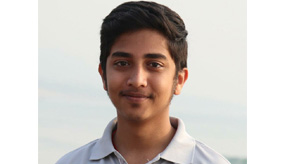 K. Sree Rama MurthySRM University-AP always inspires the students in their pursuits, be it a job of their choice or a career in research and higher studies. K. Sree Rama Murthy, a 2nd-year student of B.Tech in Computer Science and Engineering, has recently presented a research paper on “A Block-wise Histogram Shifting based Reversible Data Hiding Scheme with Overflow Handling” in the Eleventh International Conference on Computing, Communication and Networking Technologies (11th ICCCNT), held at IIT Kharagpur, India in association with IEEE Kharagpur Section, during July 1 – 3, 2020.
K. Sree Rama MurthySRM University-AP always inspires the students in their pursuits, be it a job of their choice or a career in research and higher studies. K. Sree Rama Murthy, a 2nd-year student of B.Tech in Computer Science and Engineering, has recently presented a research paper on “A Block-wise Histogram Shifting based Reversible Data Hiding Scheme with Overflow Handling” in the Eleventh International Conference on Computing, Communication and Networking Technologies (11th ICCCNT), held at IIT Kharagpur, India in association with IEEE Kharagpur Section, during July 1 – 3, 2020.
Data hiding is a process of embedding a secret message into a cover medium for secure message transmission. The reversible data hiding techniques are recently explored in the domain of data hiding in which the cover image can be recovered while extracting the hidden secret message. The overview of a reversible data hiding scheme is shown in Figure. 1.
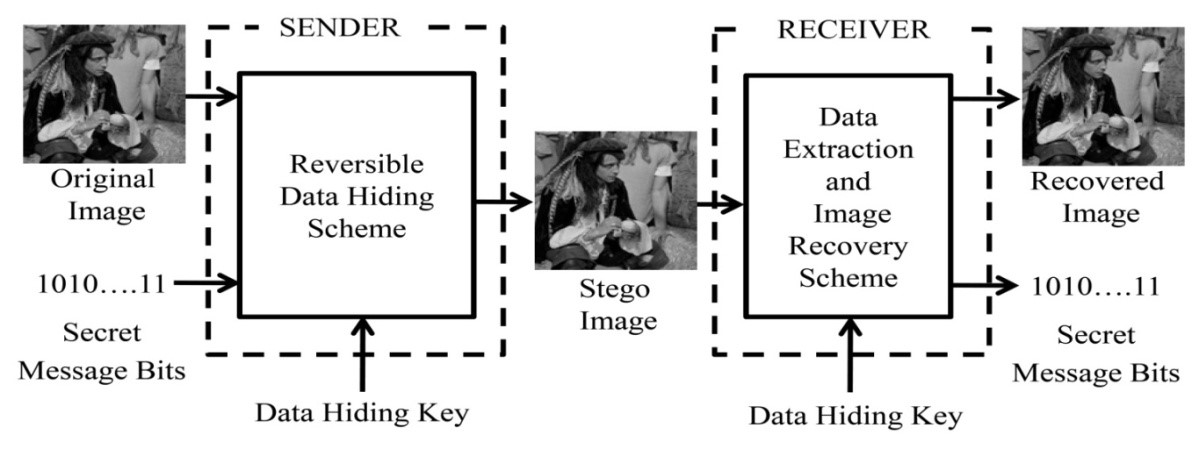 Figure 1. Overview of reversible data hiding
Figure 1. Overview of reversible data hiding
In this research paper, Sree Rama Murthy introduced a new reversible data hiding algorithm based on the histogram of the blocks of the cover images with an efficient overflow management technique to achieve a better embedding rate without compromising the visual quality of the stego image.
Design and development of reversible data hiding schemes are widely studied topic due to its wide scope in cloud computing and medical image transmission. This paper introduces a new reversible data hiding algorithm based on the histogram of the blocks of the cover images with an efficient overflow management technique. In the new scheme, the peak intensity value from each block is used for data hiding, and to make sure the correct recovery of the original image, the grayscale value used for data hiding from each block is embedded in the same block itself by replacing the least significant bits of eight selected pixels. The lossless recovery is ensured by embedding those least significant bits in the same block itself along with the secret message. Detailed theoretical analysis and experimental study of the scheme are carried out and discussed in this paper. The images from the standard image dataset of the University of Southern California (USC-SIPI) are used in their study.
“To be able to publish a research paper at such an early stage in a reputed conference like ICCCNT-2020 is an achievement that has acted as a cornerstone for my research aspirations. I feel highly encouraged, motivated and inspired to contribute more in the fields of research. I express my sincere gratitude to my professors, especially to Dr Manikandan V. M for providing me with the opportunity to collaborate. He put his trust on me, encouraged to do research with him and guided me with his knowledge and experience throughout the journey. I feel this is only the beginning for me, and I will try my best to accomplish more and retain more knowledge,” said Sree Rama Murthy.
Sree Rama Murthy plans to acquire a master’s degree in computer science and aspires to be a researcher who can make significant contributions in the domain of Computer Science and Engineering.
- Published in CSE NEWS, News, Research News
ECE student secured top prize at Independence Day Painting Competition
Monochromatic painting of Mahatma Gandhi won hearts and the first prize at the inter-department competition.
 Painting of GandhiThe Department of Electronics and Communication Engineering is very proud of its student Ms Vyshnavi Tanikonda for securing the first prize in the Independence Day Painting Competition. Ms Vyshnavi painted a beautiful monochromatic painting of Mahatma Gandhi, the ‘Father of the Nation’ who fought for the independence and sovereignty of the country till his last breath. Ms Vyshnavi, a 2nd-year student, successfully captured the true essence of the great patriot in her painting which brought her the top prize in the inter-departmental competition. The Department of ECE heartily congratulates its daughter for bringing this honour to the department.
Painting of GandhiThe Department of Electronics and Communication Engineering is very proud of its student Ms Vyshnavi Tanikonda for securing the first prize in the Independence Day Painting Competition. Ms Vyshnavi painted a beautiful monochromatic painting of Mahatma Gandhi, the ‘Father of the Nation’ who fought for the independence and sovereignty of the country till his last breath. Ms Vyshnavi, a 2nd-year student, successfully captured the true essence of the great patriot in her painting which brought her the top prize in the inter-departmental competition. The Department of ECE heartily congratulates its daughter for bringing this honour to the department.
- Published in ECE NEWS, News, Students Achievements



